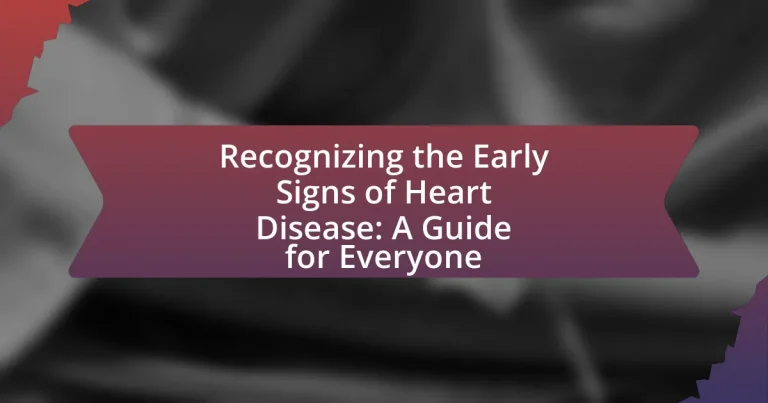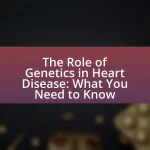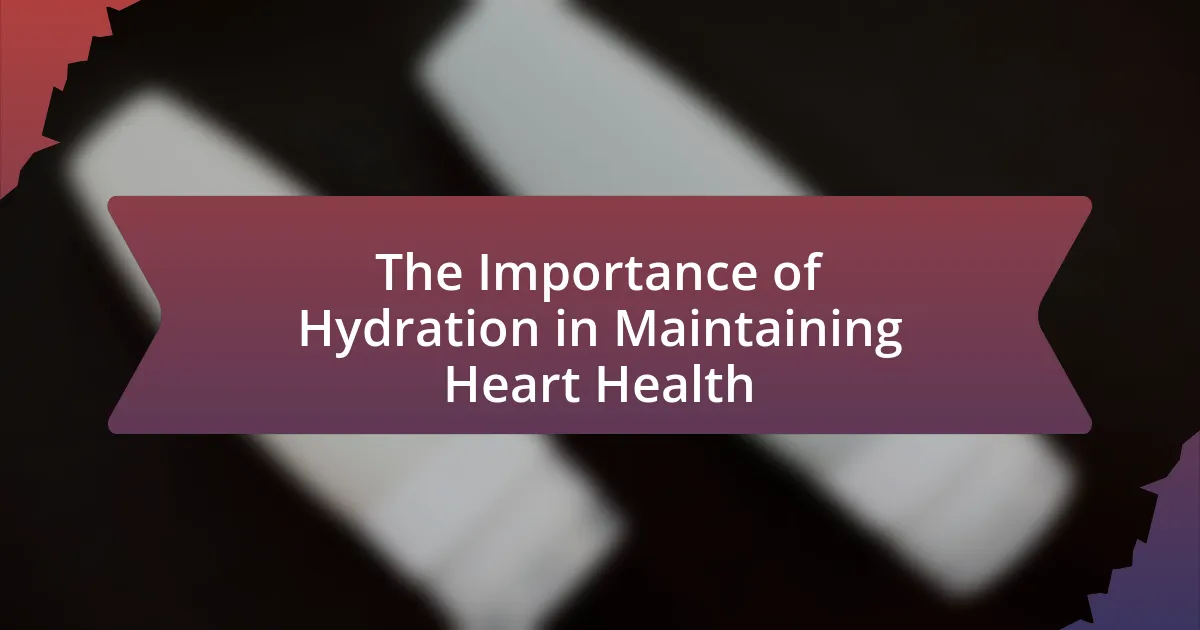The article focuses on recognizing the early signs of heart disease, emphasizing the importance of timely detection for effective management and treatment. Key symptoms include chest pain, shortness of breath, fatigue, and irregular heartbeats, with variations noted between men and women. It discusses risk factors such as high blood pressure, high cholesterol, smoking, obesity, and lifestyle choices that contribute to heart disease. The article also highlights the significance of regular health monitoring, lifestyle changes, and understanding genetic predispositions in preventing heart disease. Additionally, it provides guidance on how to respond to symptoms and resources for further education on heart health.
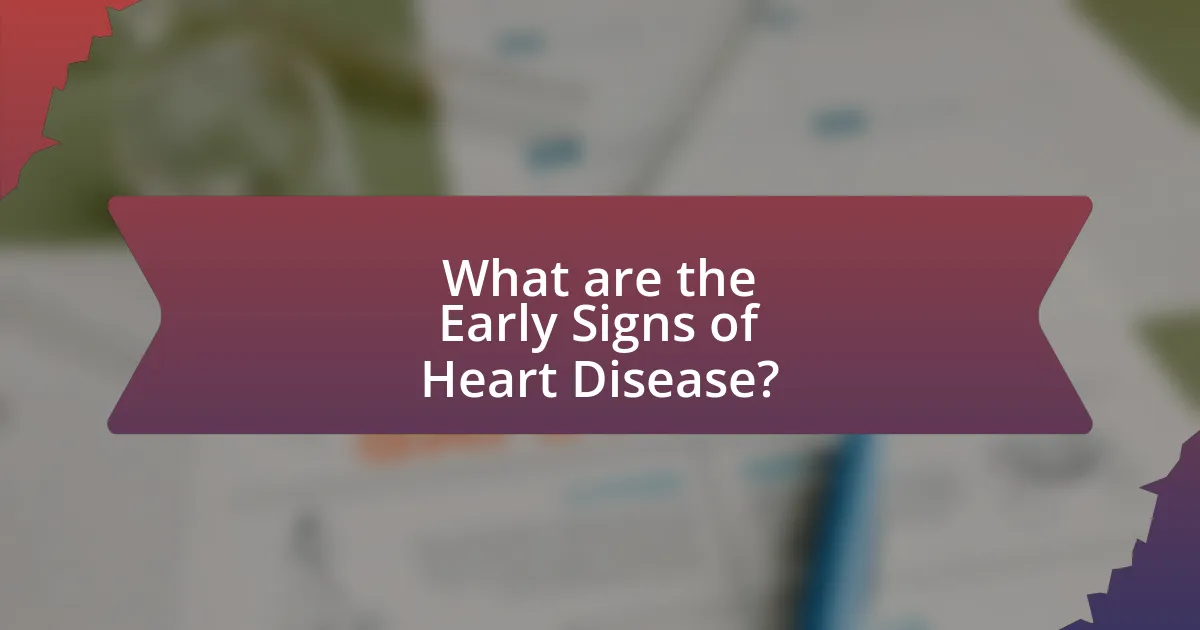
What are the Early Signs of Heart Disease?
The early signs of heart disease include chest pain, shortness of breath, fatigue, and irregular heartbeats. Chest pain, often described as pressure or tightness, can indicate reduced blood flow to the heart. Shortness of breath may occur during physical activity or at rest, signaling potential heart issues. Fatigue that is unusual or persistent can be a warning sign, particularly in women. Irregular heartbeats, or palpitations, can also suggest underlying heart problems. According to the American Heart Association, recognizing these symptoms early can lead to timely medical intervention, which is crucial for effective management and treatment of heart disease.
How can you identify symptoms of heart disease early?
To identify symptoms of heart disease early, individuals should monitor for key indicators such as chest pain, shortness of breath, fatigue, and irregular heartbeats. These symptoms often manifest as discomfort in the chest, which may feel like pressure, squeezing, or fullness, and can radiate to the arms, back, neck, or jaw. Research indicates that early recognition of these symptoms can significantly improve outcomes; for instance, the American Heart Association states that prompt medical attention can reduce the risk of severe complications. Regular check-ups and awareness of personal risk factors, such as family history and lifestyle choices, further enhance the ability to detect heart disease symptoms early.
What specific symptoms should you look for in men?
Men should look for specific symptoms such as chest pain, shortness of breath, fatigue, and irregular heartbeats, which are indicative of heart disease. Chest pain may present as pressure or discomfort in the center or left side of the chest, often described as a feeling of fullness or squeezing. Shortness of breath can occur during physical activity or at rest, signaling potential heart issues. Fatigue that is unusual or persistent may indicate heart problems, especially if it is accompanied by other symptoms. Irregular heartbeats, or palpitations, can also be a warning sign of underlying heart conditions. According to the American Heart Association, recognizing these symptoms early can lead to timely medical intervention and improved outcomes for heart disease.
What specific symptoms should you look for in women?
Women may experience specific symptoms of heart disease that differ from those typically seen in men. Key symptoms to look for include chest pain or discomfort, shortness of breath, fatigue, nausea, and pain in the neck, jaw, or back. Research indicates that women are more likely to report atypical symptoms, which can lead to misdiagnosis. For instance, a study published in the Journal of the American College of Cardiology found that women often present with symptoms such as fatigue and shortness of breath rather than the classic chest pain associated with heart attacks. Recognizing these symptoms is crucial for early intervention and treatment.
Why is it important to recognize these signs early?
Recognizing the early signs of heart disease is crucial because early detection can significantly improve treatment outcomes and reduce the risk of severe complications. Studies indicate that timely intervention can lower the likelihood of heart attacks and other cardiovascular events by up to 50%. Early recognition allows for lifestyle changes, medication adjustments, and monitoring that can prevent the progression of the disease. Furthermore, the American Heart Association emphasizes that awareness of symptoms such as chest pain, shortness of breath, and fatigue can lead to prompt medical evaluation, ultimately saving lives.
How does early detection impact treatment outcomes?
Early detection significantly improves treatment outcomes for heart disease by allowing for timely interventions that can prevent disease progression. When heart disease is identified early, patients can receive appropriate lifestyle modifications, medications, or surgical options sooner, which can lead to better management of symptoms and reduced risk of complications. Studies indicate that early diagnosis can decrease mortality rates; for instance, research published in the Journal of the American College of Cardiology shows that patients diagnosed with heart disease at an early stage have a 50% higher survival rate compared to those diagnosed later. This evidence underscores the critical role of early detection in enhancing the effectiveness of treatment strategies and improving overall patient prognosis.
What are the risks of ignoring early signs?
Ignoring early signs of heart disease significantly increases the risk of severe health complications, including heart attacks and strokes. Early symptoms, such as chest pain, shortness of breath, or fatigue, often indicate underlying cardiovascular issues that, if left unaddressed, can lead to irreversible damage to the heart and blood vessels. According to the American Heart Association, timely intervention can reduce the risk of heart disease-related mortality by up to 50%. Therefore, neglecting these warning signs can result in a higher likelihood of emergency medical situations, prolonged recovery times, and increased healthcare costs.
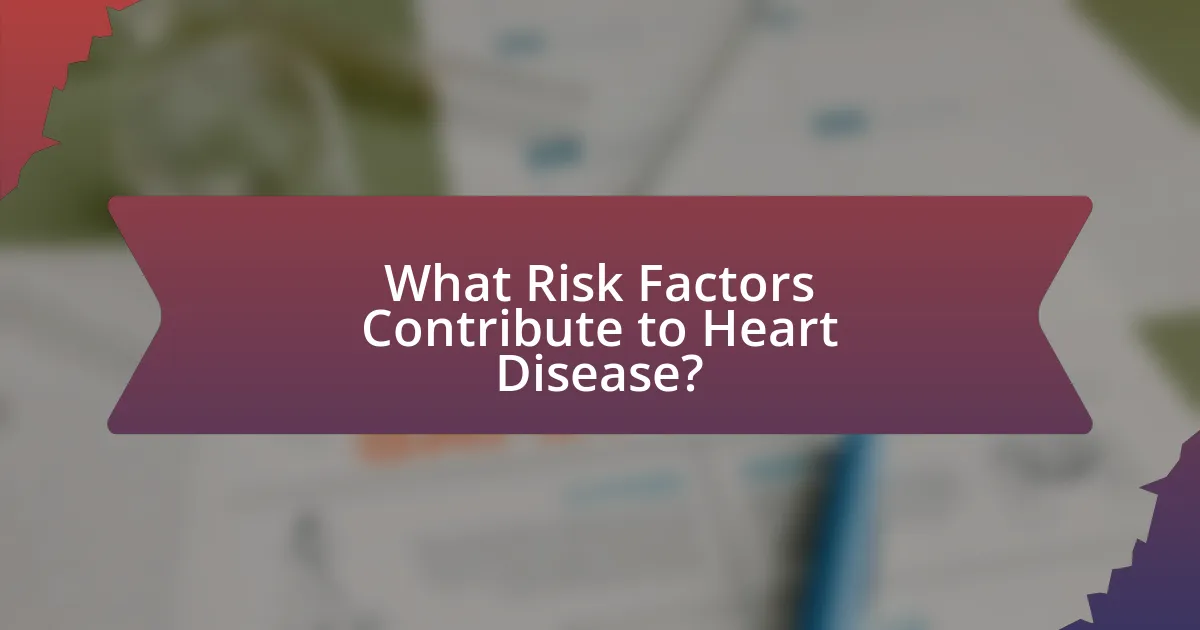
What Risk Factors Contribute to Heart Disease?
Risk factors that contribute to heart disease include high blood pressure, high cholesterol, smoking, obesity, physical inactivity, diabetes, and a poor diet. High blood pressure affects nearly half of adults in the U.S., increasing the risk of heart disease significantly. High cholesterol levels can lead to plaque buildup in arteries, while smoking damages blood vessels and reduces oxygen in the blood. Obesity is linked to conditions like diabetes and hypertension, further elevating heart disease risk. Physical inactivity contributes to weight gain and poor cardiovascular health. Diabetes increases the likelihood of heart disease due to elevated blood sugar levels damaging blood vessels. Lastly, a diet high in saturated fats, trans fats, and sodium can lead to increased cholesterol and blood pressure, compounding these risks.
How do lifestyle choices affect heart disease risk?
Lifestyle choices significantly influence heart disease risk by affecting factors such as blood pressure, cholesterol levels, and overall cardiovascular health. For instance, a diet high in saturated fats and sugars can lead to obesity and elevated cholesterol, both of which are major risk factors for heart disease. Regular physical activity, on the other hand, helps maintain a healthy weight and lowers blood pressure, thereby reducing heart disease risk. According to the American Heart Association, individuals who engage in at least 150 minutes of moderate aerobic exercise weekly can lower their risk of heart disease by up to 30-40%. Additionally, smoking cessation is crucial, as tobacco use is linked to a 70% increase in heart disease risk. Thus, adopting healthier lifestyle choices can substantially decrease the likelihood of developing heart disease.
What role does diet play in heart health?
Diet plays a crucial role in heart health by influencing cholesterol levels, blood pressure, and overall cardiovascular risk. A diet rich in fruits, vegetables, whole grains, and lean proteins can lower the risk of heart disease. For instance, the American Heart Association recommends a diet low in saturated fats, trans fats, and sodium, which has been shown to reduce the incidence of heart-related issues. Studies indicate that adhering to a Mediterranean diet, which emphasizes healthy fats like olive oil and nuts, can decrease the risk of heart disease by up to 30%. Thus, dietary choices directly impact heart health and can significantly alter cardiovascular outcomes.
How does physical activity influence heart disease risk?
Physical activity significantly reduces the risk of heart disease by improving cardiovascular health and lowering risk factors such as high blood pressure, high cholesterol, and obesity. Engaging in regular exercise strengthens the heart muscle, enhances blood circulation, and promotes better oxygen utilization. According to the American Heart Association, individuals who participate in at least 150 minutes of moderate-intensity aerobic activity per week can lower their risk of heart disease by up to 30-40%. Additionally, physical activity helps manage stress and improves overall mental health, further contributing to heart disease prevention.
What genetic factors should you consider?
Genetic factors to consider in relation to heart disease include family history, specific gene mutations, and inherited conditions. Family history significantly increases the risk of heart disease; individuals with close relatives who have experienced heart issues are more likely to develop similar problems. Specific gene mutations, such as those in the LDLR gene associated with familial hypercholesterolemia, can lead to elevated cholesterol levels and increased heart disease risk. Additionally, inherited conditions like hypertrophic cardiomyopathy can also predispose individuals to heart complications. These genetic factors underscore the importance of understanding one’s family medical history and potential genetic predispositions when assessing heart disease risk.
How can family history affect your risk of heart disease?
Family history significantly affects your risk of heart disease due to genetic predispositions and shared lifestyle factors. Individuals with a family history of heart disease are more likely to inherit genes that increase susceptibility to conditions such as high blood pressure, high cholesterol, and diabetes, which are major risk factors for heart disease. Research indicates that having a first-degree relative with heart disease doubles the risk of developing the condition yourself. Additionally, familial patterns of diet, exercise, and smoking can further influence heart health, as these behaviors often persist across generations.
What genetic markers are associated with heart disease?
Genetic markers associated with heart disease include variations in genes such as LDLR, APOB, and PCSK9. These genes are linked to lipid metabolism and cholesterol levels, which are critical factors in cardiovascular health. For instance, mutations in the LDLR gene can lead to familial hypercholesterolemia, significantly increasing the risk of heart disease. Additionally, single nucleotide polymorphisms (SNPs) in the 9p21 locus have been identified as strong predictors of coronary artery disease. Studies have shown that individuals with specific variants in these genes exhibit a higher prevalence of heart disease, underscoring the importance of genetic testing in assessing cardiovascular risk.
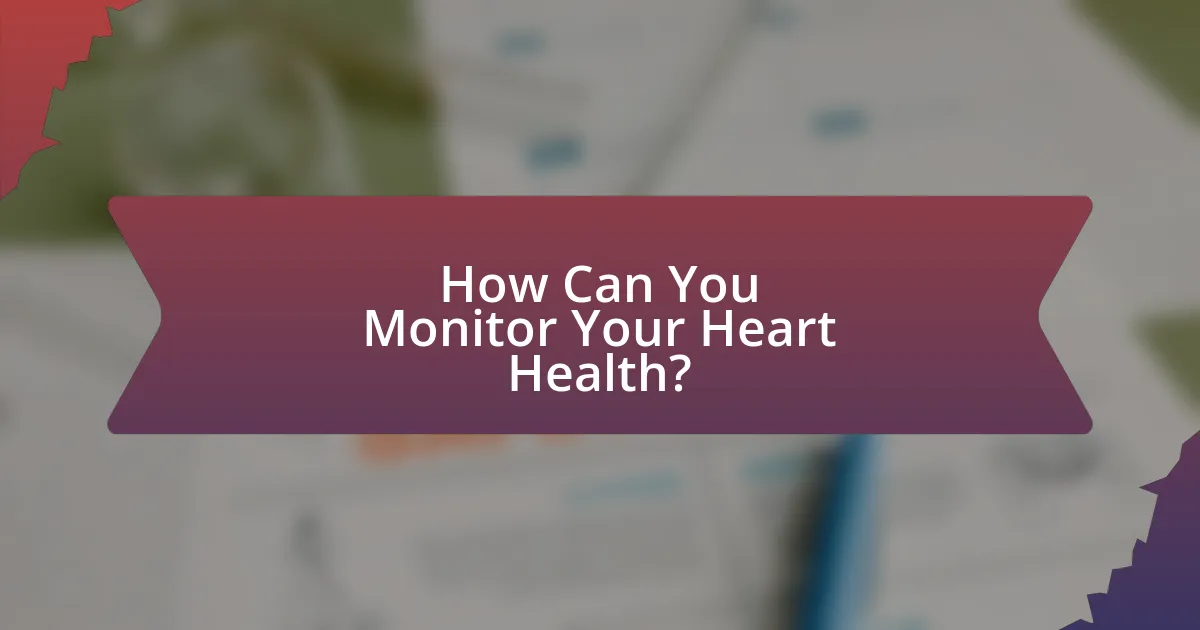
How Can You Monitor Your Heart Health?
To monitor your heart health, regularly check your blood pressure, cholesterol levels, and heart rate. These metrics provide essential insights into cardiovascular function and overall heart health. For instance, maintaining a blood pressure below 120/80 mmHg is considered optimal, while cholesterol levels should ideally be below 200 mg/dL for total cholesterol. Additionally, tracking your resting heart rate, which typically ranges from 60 to 100 beats per minute, can indicate fitness levels and heart efficiency. Regular check-ups with a healthcare provider can further ensure comprehensive monitoring and early detection of potential heart issues.
What regular check-ups should you schedule?
You should schedule regular check-ups that include a comprehensive cardiovascular assessment, blood pressure monitoring, cholesterol level testing, and diabetes screening. These check-ups are essential for early detection of heart disease risk factors. According to the American Heart Association, regular monitoring of blood pressure and cholesterol can significantly reduce the risk of heart disease by allowing for timely interventions. Additionally, the U.S. Preventive Services Task Force recommends diabetes screening for adults with risk factors, as diabetes is a major contributor to heart disease.
How often should you have your blood pressure checked?
You should have your blood pressure checked at least once every two years if your readings are normal (less than 120/80 mmHg). For individuals with elevated blood pressure (120-129/less than 80 mmHg) or those with risk factors for heart disease, annual checks are recommended. Regular monitoring is crucial as high blood pressure often has no symptoms, and early detection can prevent complications related to heart disease. The American Heart Association supports these guidelines to promote cardiovascular health.
What tests can help assess your heart health?
Tests that can help assess heart health include electrocardiograms (ECGs), echocardiograms, stress tests, and blood tests for cholesterol and other markers. ECGs measure the electrical activity of the heart, helping to identify arrhythmias and other issues. Echocardiograms use ultrasound to visualize heart structure and function, revealing problems with heart valves or chambers. Stress tests evaluate heart performance under physical exertion, indicating how well the heart handles increased workload. Blood tests can measure levels of cholesterol, triglycerides, and other substances that affect heart health, providing insight into cardiovascular risk factors. These tests are essential for early detection and management of heart disease.
What lifestyle changes can you implement for better heart health?
To improve heart health, individuals should adopt a balanced diet, engage in regular physical activity, maintain a healthy weight, manage stress, and avoid smoking. A balanced diet rich in fruits, vegetables, whole grains, and lean proteins can lower cholesterol and blood pressure, reducing heart disease risk. Regular physical activity, such as 150 minutes of moderate exercise weekly, strengthens the heart and improves circulation. Maintaining a healthy weight is crucial, as obesity significantly increases the risk of heart disease. Stress management techniques, such as mindfulness and relaxation exercises, can lower heart rate and blood pressure. Lastly, avoiding smoking is essential, as it damages blood vessels and increases the likelihood of heart disease. According to the American Heart Association, these lifestyle changes can lead to a 50% reduction in heart disease risk.
How can stress management techniques improve heart health?
Stress management techniques can improve heart health by reducing the physiological effects of stress, which include elevated blood pressure and increased heart rate. Chronic stress contributes to heart disease by promoting inflammation and unhealthy behaviors such as poor diet and lack of exercise. Techniques such as mindfulness, meditation, and regular physical activity have been shown to lower stress levels, thereby decreasing the risk of cardiovascular issues. For instance, a study published in the Journal of the American College of Cardiology found that individuals who practiced stress management techniques had a 30% lower risk of heart disease compared to those who did not engage in such practices.
What dietary changes can support heart health?
To support heart health, individuals should adopt a diet rich in fruits, vegetables, whole grains, lean proteins, and healthy fats. Research indicates that diets such as the Mediterranean diet, which emphasizes these food groups, can significantly reduce the risk of cardiovascular diseases. For instance, a study published in the New England Journal of Medicine found that participants following a Mediterranean diet had a 30% lower risk of heart disease compared to those on a standard low-fat diet. Additionally, reducing saturated fats and trans fats while increasing omega-3 fatty acids from sources like fish can further enhance heart health.
What are the best practices for recognizing and responding to heart disease symptoms?
The best practices for recognizing and responding to heart disease symptoms include being aware of common signs such as chest pain, shortness of breath, fatigue, and irregular heartbeats. Individuals should monitor these symptoms closely and seek immediate medical attention if they experience severe chest pain, especially if it radiates to the arms, back, neck, or jaw, as this may indicate a heart attack. Additionally, understanding personal risk factors, such as family history, high blood pressure, and high cholesterol, can aid in early detection. Regular check-ups with healthcare providers for cardiovascular assessments are also crucial, as they can identify potential issues before they escalate. According to the American Heart Association, timely intervention can significantly improve outcomes for those experiencing heart disease symptoms.
How should you react if you experience symptoms of heart disease?
If you experience symptoms of heart disease, you should seek immediate medical attention. Symptoms such as chest pain, shortness of breath, or discomfort in the arms, back, neck, jaw, or stomach indicate a potential heart issue. According to the American Heart Association, timely intervention can significantly improve outcomes in heart disease cases, as early treatment can prevent severe complications or even death.
What resources are available for further education on heart health?
Resources available for further education on heart health include the American Heart Association, which provides comprehensive information on heart disease prevention and management. The Centers for Disease Control and Prevention (CDC) offers statistics and guidelines on heart health, while the National Heart, Lung, and Blood Institute (NHLBI) provides research-based resources and educational materials. Additionally, online platforms like MedlinePlus and Healthline offer articles and videos on heart health topics. These organizations are recognized for their authoritative content and commitment to public health education.
